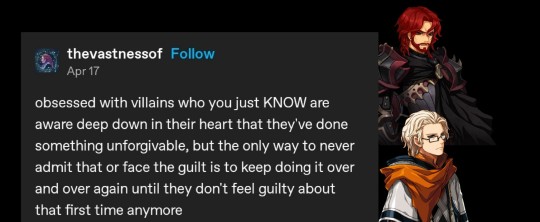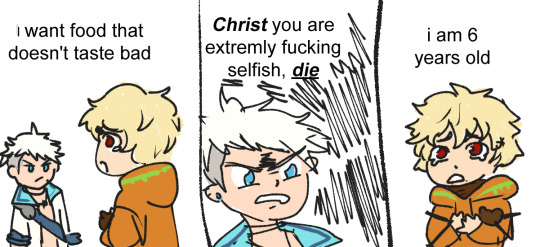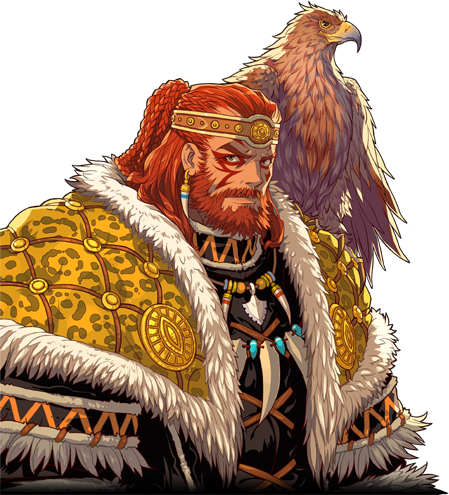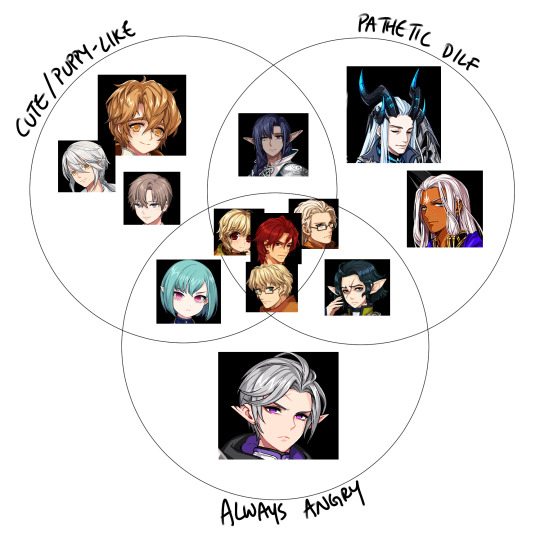#tarlach
Text





mainly ruairi stuff, but here's some mabi memes
74 notes
·
View notes
Text



the friendship they deserved to have, tbh
48 notes
·
View notes
Text
TARLACH - Mabinogi


PROPAGANDA:
I've loved this guy since I first started playing the game back in 2008. He's a druid who lost his magic and he turns into a bear during the day to conserve his energy. He once told me he didn't have anything to give me for a Halloween trick or treat event and then ate hard candy in front of me. He's apparently not great at singing despite music being a part of his magic. In later storylines he becomes convinced that the only way to achieve happiness in his world is to destroy the gods..... But it's understandable, he's been through a lot, alright, I forgive him.
49 notes
·
View notes
Text

I didn't like Merlin very much in Saga 2, bc his attitude the whole time was just this.
#mabinogi#Tarlach#mabinogi Merlin#Mabinogi Tarlach#Merlin#meme redraw#fanart#digital art#Imagine beefing with a literal baby bc the girl you simp for is trying to be a good babysitter#meme
28 notes
·
View notes
Text

Mari, Tarlach, and Ruairi showcasing the 19th Anniversary Fantasy Party Showcase Gift Box items on Mabi KR's site.
19 notes
·
View notes
Text



#mabinogi#wanst#tarlach#krug#get it. get it because tarlach turns into-#i hope this poll breaches containment
11 notes
·
View notes
Text

Kek money well spent
1 note
·
View note
Text

hey listen hear me out I made a venn diagram of mabinogi npc men with very specific traits
#mabinogi#meme#this came about because I was drawing manannan and I had a moment#older!ruairi is all three but tarlach is literally all three
43 notes
·
View notes
Text
For anyone wondering why I'm posting polar bears all of the sudden... I've had some brainworms for an old WoL/Azem OC of mine :).
I've decided that as Arcturus, Tarlach's familiar was a polar bear. Its name was Lampros ("radiant" in Greek) and it had brilliant-white fur, befitting both its name and Arcturus's other title as the Warrior of Light. Hades hated looking at it- he thought it was gaudy and its fur blinded him. Hythlodaeus loved it, precisely because it was so flashy.
Also as Arcturus, Tarlach would occasionally transform into a giant bear for situations where physical combat was more suitable than magic.
#oc info: tarlach mathuin#he's based off of a character from another mmo who had to transform into a bear during the day to survive#hence the bear motif
5 notes
·
View notes
Text
i wanna commission someone to draw my baldurs gate pc and karlach bein romantic together
1 note
·
View note
Photo

Are the Benin Bronzes Made From German Brass—And Does It Matter?
On a humid February day in 1897, with smoke from relentless shelling hanging heavy in the royal city, the invading force advanced. More than a thousand British soldiers, bolstered by auxiliary troops, attacked the centuries-old seat of the forest kingdom, among the most powerful in West Africa. England would claim the military operation was retaliation for the killings of a few of its citizens after they violated the kingdom’s sovereignty. But in truth, it was a ruthless assault to vanquish the Kingdom of Benin and gain control of its wealth. By the time it was over, Benin City was in ashes. Amid the untold civilian casualties, destruction of homes, and other brutalities, the invaders looted thousands of royally-commissioned figures, masks, plaques, and other objects, some carved from wood or ivory but most cast in brass or bronze. Collectively known today as the Benin Bronzes, these treasures were hauled to the coast, loaded onto ships, and, eventually, made their way to some of the most famous museums and private collections in Europe and the United States. There, for more than a century, the Benin Bronzes were displayed, often without mention of their significance as religious or commemorative objects. More recently, as the importance of the Benin Bronzes as cultural heritage has been more broadly acknowledged, the magnificently detailed faces and intricate scenes of royal life have been at the center of often-heated political, cultural, and legal debates over repatriation and reparation for their violent theft. Now, there’s a new wrinkle in the story. Published today in the journal PLoS One, a novel geochemical analysis suggests that the raw material used in the production of Benin’s famous metalworks came from Rhineland, in western Germany. The findings are a scientific first, but the bigger question is: Does it matter where the metal came from? “I don’t think this is of enormous interest to the Edo people themselves. Where the material originally came from is a bit neither here nor there,” says Barnaby Phillips, journalist and author of Loot: Britain and the Benin Bronzes. (The term "Edo" can refer to both the historic kingdom of Benin, also known as the Benin Empire or Edo Empire, and the modern Nigerian state, located at what was the heart of the ancient kingdom; some experts prefer to use the term Edo to distinguish the kingdom and its people from the modern country of Benin, to the west of Nigeria.) Perhaps the most interesting thing about the paper is its method: The team compiled data from previously published analyses of metals used in objects considered Benin Bronzes, and compared those results with new analysis of something perhaps unexpected: artifacts retrieved from shipwrecks. Specifically, the team analyzed the composition of dozens of objects called manillas, retrieved from five shipwreck sites around the Atlantic and three archaeological sites in West Africa and Europe. Manillas are small, c-shaped pieces of brass that were manufactured in Europe and used by Portuguese traders as currency along much of the West African coast from the late 15th to the 19th century. All of the manillas analyzed in the study came from sites or shipwrecks, from Massachusetts to Sierra Leone, that had ties to Portuguese trade during this era. After comparing the previously published chemical signatures of the Benin objects with those of the manillas and an established database of European ores, the researchers concluded that “this study definitively identifies the Rhineland as the principal source of manillas.… Millions of these artifacts were sent to West Africa where they likely provided the major, virtually the only, source of brass for West African casters between the 15th and the 18th centuries.” It’s the first time anyone has tied the raw material ultimately used to produce the Benin objects to a specific geographic area—but a European origin for the material is not a surprise to scholars familiar with the Benin Bronzes. “A significant part of the metal that constitutes Benin bronze came from Europe. It’s only natural to start with the Portuguese connection [when researching its origin],” says Ndubuisi Ezeluomba, curator of African art at the Virginia Museum of Fine Arts in Richmond. Ezeluomba, who has written extensively about the objects from an arts management perspective, says he found the paper “exciting,” but would like to see more details. Despite the new paper’s emphasis on a German origin for the raw material Benin artists used, brass objects had been produced in West Africa long before European contact. While some regional metalworking traditions lasted for a century or two, the Kingdom of Benin’s casters were at work for at least 500 years, and possibly much longer. “What helped in the Benin case was it was under the control of the king, he was the sole patron at that time,” says Ezeluomba. “These were not objects made for the ordinary person. They were made to beautify the palace and decorate royal shrines. All the plaques you see were just like normal photographs, put on the palace wall to decorate them.” Despite its longevity—or perhaps because of it—the very roots of Benin’s bronze and brass casting tradition remain a mystery, and a source of contention between people in today’s Edo state and surrounding regions, notably the Yoruba people to the northwest, many of whom have ancestral ties to the ancient Ife Kingdom. The dates of manufacture for many of the items are also uncertain or contested. “There is a great historic rivalry between the Ife and Benin kingdoms, and there is a great deal of sensitivity as to which came first and which influenced the other,” says Phillips. “[But] the Ife civilization is producing these amazing objects, certainly predating contact with the Europeans.… Of course, Edo historians are adamant that their own metal casting tradition, be it bronze or brass, predates the arrival of the Europeans.” One thing researchers, historians, and curators alike agree on: “The arrival of the Europeans is a catalyst for expanded production,” says Phillips, adding that the sudden and substantial availability of brass, in the form of manillas, would have given the Benin artists much more material to work with. The paper’s lead author and designated media contact Tobias Skowronek declined interview requests for this story. Skowronek is a geochemist at the Technische Hochschule Georg Agricola in Bochum, near Dusseldorf and coincidentally close to the area where his team believes the raw material for the Benin Bronzes was mined. Some feel the new research may be less about a scientific breakthrough and more about researchers wanting to participate in some way in the broader discussion of the objects, currently a popular topic on social media and elsewhere. “The Benin Bronzes have become emblematic of the debate around colonial looted art for a couple of reasons. The first reason is that they are very fabulous, [and] the way in which they were taken was particularly egregious,” says Phillips. “And if you’re more or less anywhere between Seattle and Stockholm, there are Benin Bronzes in your nearest museum. So it has great resonance in different countries and has fitted into the postcolonial discourse.” It’s unclear what, if any, impact the new paper may have on ongoing political and legal maneuvering around efforts to return the artifacts to Nigeria. While museums in some countries, notably Germany, have already returned dozens of the objects or have committed to do so, some opposition continues. In 2022, the Restitution Study Group (RSG), which describes itself as a nonprofit concerned with slavery justice, launched a legal challenge to the Smithsonian Institution’s transfer of ownership of several objects to the Nigerian government. RSG’s argument is that the Benin Bronzes are culturally significant to descendants of enslaved people in the United States, and should remain accessible to them, because they were cast from melted-down manillas that Europeans traded with Benin nobility “in exchange for abducted and enslaved neighboring non-Beni people.” ("Beni" or "Bini" is another name for the language, also known as Edo, spoken in the kingdom.) While a judge denied RSG’s attempt to stop the transfer in October, the legal battle points to a question of much greater significance than where the metal in the Portuguese manillas was mined: “To put it crudely, to what extent were these [manillas] being traded for slaves?” says Phillips. The answer, based on historical evidence, appears to be that the Kingdom of Benin had fewer connections to the transatlantic slave trade than other regional kingdoms. “The history of how those things were removed, that’s what gets me.” Phillips notes that the forest kingdom, which was inland and not directly accessible to ships involved in the slave trade, had significant natural resources and industries, such as palm oil, ivory, and textiles. “I think Edo historians are on to something when they say their own kingdom was a lot more powerful than many of the other kingdoms that Europeans engaged with, and crucially had other things the Europeans wanted to buy,” he adds. While the links between the slave trade and the manillas melted down for the casters’ use remain uncertain and controversial, the brutality with which the Benin Bronzes were taken is incontrovertible. Ezeluomba, who grew up in modern Benin City, says he considers the objects as art, and studies them with professional detachment. However, he adds, “The history of how those things were removed, that’s what gets me. The sheer scale of the human casualties that these guys unleashed on Benin, the number of bullets that came out of those machine guns, those are the facts that actually get me.… It was very brutal. I always have that in the back of my mind.” For advocates of the return of the Benin Bronzes to what is now Nigeria, repatriation is a start, but only the first step in what must be a thoughtful process of remediation. Ezeluomba says it’s not just about returning the stolen goods to Benin City; Western museums, governments, and scholars should assist in infrastructure building, training, and other initiatives that will preserve the items for generations to come. Considered in this broader context, the question of whether the Benin Bronzes were cast from material mined in western Germany is a footnote. “If a Nigerian artist buys all their paints and canvas from Europe, is it European art?” Ezeluomba asks. “It’s not about the materials, it’s about who made the work.”
https://www.atlasobscura.com/articles/benin-bronze-origins
0 notes
Text







mabi but onion headlines because I think it's funny
51 notes
·
View notes
Text

somewhere nearby, Mari is pretending to be grossed out
#mabinogi#tarlach#ruairi#i am in love w ruairis sleeveless turtleneck#and i think the three of them deserve at least one timeline where things went okay#still travelling together. mari making fun of them the whole time
22 notes
·
View notes
Text

---



For the Maya, the honey bee is more than an insect. For millennia, the tiny, stingless species Melipona beecheii -- much smaller than Apis mellifera, the European honey bee -- has been revered in the Maya homeland in what is now Central America. Honey made by the animal the Maya call Xunan kab has long been used in a sacred drink, and as medicine to treat a whole host of ailments, from fevers to animal bites. The god of bees appears in relief on the walls of the imposing seacliff fortress of Tulum, the sprawling inland complex of Cobá, and at other ancient sites.
Today, in small, open-sided, thatched-roof structures deep in the tropical forests of Mexico’s Yucatán Peninsula, traditional beekeepers still tend to Xunan kab colonies. The bees emerge from narrow openings in their hollow log homes each morning to forage for pollen and nectar among the lush forest flowers and, increasingly, the cultivated crops beyond the forests’ shrinking borders. And that is where the sacred bee of the Maya gets into trouble.
---
In 2012, the Mexican government granted permission to Monsanto to plant genetically modified soybeans in Campeche and other states on the peninsula without first consulting local communities. The soybeans are engineered to withstand high doses of the controversial weedkiller Roundup; multiple studies have shown exposure to its main ingredient, glyphosate, negatively impacts bees, including by impairing behavior and changing the composition of the animals’ gut microbiome. Though soy is self-pollinating and doesn’t rely on insects, bees do visit the plants while foraging, collecting nectar and pollen as they go. Soon, Maya beekeepers found their bees disoriented and dying in high numbers. And Leydy Pech found her voice.
A traditional Maya beekeeper from the small Campeche city of Hopelchén, Pech had long advocated for sustainable agriculture and the integration of Indigenous knowledge into modern practice. But the new threat to her Xunan kab stirred her to action as never before. She led an assault on the Monsanto program on multiple fronts: legal, academic, and public outrage, including staging protests at ancient Maya sites. The crux of the legal argument by Pech and her allies was that the government had violated its own law by failing to consult with Indigenous communities before granting the permit to Monsanto. In 2015, Mexico’s Supreme Court unanimously agreed. Two years later, the government revoked the permit to plant the crops.
---
As Pech saw it, the fight was not simply about protecting the sacred bee. The campaign was to protect entire ecosystems, the communities that rely on them, and a way of life increasingly threatened by the rise of industrial agriculture, climate change, and deforestation.
“Bees depend on the plants in the forest to produce honey,” she told the public radio program Living on Earth in 2021. “So, less forest means less honey [...]. Struggles like these are long and generational. [...] ”
---
Headline, images, captions, and all text by: Gemma Tarlach. “The Keeper of Sacred Bees Who Took on a Giant.” Atlas Obscura. 23 March 2022. [The first image in this post was not included with Atlas Obscura’s article, but was added by me. Photo by The Goldman Environmental Prize, from “The Ladies of Honey: Protecting Bees and Preserving Tradition,” published online in May 2021. With caption added by me.]
4K notes
·
View notes
Text
WEEK FOUR LINEUP
Some minor changes this week, we have officially retired the SEE RESULTS option on the polls, down to five options. I probably won't be adding any new options unless there's a very good reason or high demand, so I'm sorry to the people who have asked for a "I know them and I love them with all my heart, positive cannot contain the love I have for them" option. With that being said, here is this week's lineup!
Mimi - Your Imaginary Friend
Tsubasa Arihara - Cinderella Nine
Tablet - Commodity Clash
Fox Alistair - RWBY
Alan B'Stard - The New Statesman
Sportacus - LazyTown
Tougou Mimori - Yuuki Yuuna is a Hero & Washio Sumi is a Hero
Rottytops - Shantae
Naomasa Tsukauchi - Boku no Hero Academia
Hagumi Hanamoto - Honey and Clover
Bellringer - Toontown Corporate Clash
Tarlach - Mabinogi
Ata Ibusuki - Binan Koukou Chikyuu Boueibu Happy Kiss
J - Heat Guy J
Mami Tomoe - Madoka Magica
Rocket Raccoon - Marvel Cinematic Universe
Princess Elle - Hirogaru Sky Precure
Phèdre nó Delaunay - Kushiel's Legacy series
Rex Mohs - Scott the Woz
Eileen Roberts - Regular Show
Waluigi - Super Mario
Rick - Denpa Men
Great Sage - Miitopia
Sidon - Legend of Zelda
John F. Kennedy - Clone High
Greg Heffley - Diary of a Wimpy Kid
Martin - Wii Sports
Yellow Face - Battle for Dream Island
Eraser - Battle for Dream Island
9-Volt - WarioWare
Luigi - Super Mario
Milo Murphy - Milo Murphy's Law
Rigby - Regular Show
Holidog - Holiday World
Jerry Attricks - Scott the Woz
Jeb Jab - Scott the Woz
Peter Griffin - Family Guy
Baljeet Tjinder - Phineas and Ferb
Gary - Regular Show
Skelly - I Spy Spooky Mansion
Max Schnell - Cars 2
Charley - Incredibox
10th Doctor - Doctor Who
Mii Brawler - Super Smash Bros
Miles Morales - Into and Across the Spiderverse
Party Phil - Wii Party
Lego Joker - Lego Batman
Knife - Inanimate Insanity
Fusk and Vorte - Hitmen for Destiny
Chaika Trabant - Hitsugi no Chaika
Jesse Pinkman - Breaking Bad
Agent - Penguinronpa
Squelch - Denpa Men
Muscle Man - Regular Show
Fuuta Kajiyama - MILGRAM
Jonathan Phaedrus / Prof - The Reckoners
David Charleston - The Reckoners
Spensa - Skyward
M-Bot - Skyward
Chet Starfinder - Skyward
Sirius Gibson - Witch’s Heart
Guy Montag - Fahrenheit 451
Zachary Zatara - DC Comics
Kento - Payday 2
The Shapeshifter - The Odd Squad
Akane Kurashiki - Zero Escape Trilogy
Letitia "Letty" Price - Babel
The Last Son of Alcatraz - The Monument Mythos
Lily - Duolingo
Ohio - The United States of America
Myne - Ascendance of a Bookworm
Rani - Disney Fairies
Agrael/Raelag - Heroes of Might and Magic
Donna - RErideD: Tokigoe no Derrida
Kasane Teto - Vocaloid
Martin the Warrior - Redwall
Colombo - Colombo
Sonny Wortzik - Dog Day Afternoon
Butch Cassidy - Butch Cassidy and the Sundance kid
Blondie - The Good The Bad and The Ugly
Prior Walter - Angels in America
Dark - Nowhere
Reona West - PriPara
Shax Lied - Mairimashita! Iruma-Kun
Villager - Minecraft
Wahanly Shume - Tenchi Muyo! War on Geminar
Qifrey - Witch Hat Atelier
Marvin - In Trousers
Mr. Bungee - A New Brain
Mayor Mingus - Dialtown
KAITO - Vocaloid
Almond - Postknight 2
Serial Designation V - Murder Drones
Flint - Postknight 2
Magnolia - Postknight 2
Nobara Kugisaki - Jujutsu Kaisen
Snufkin - The Moomins
Ikabod Kee - The Upturned
The Professor - Hailey's On It!
Chimumu - Waccha PriMagi
Mia Taylor - Love Live
30 notes
·
View notes
